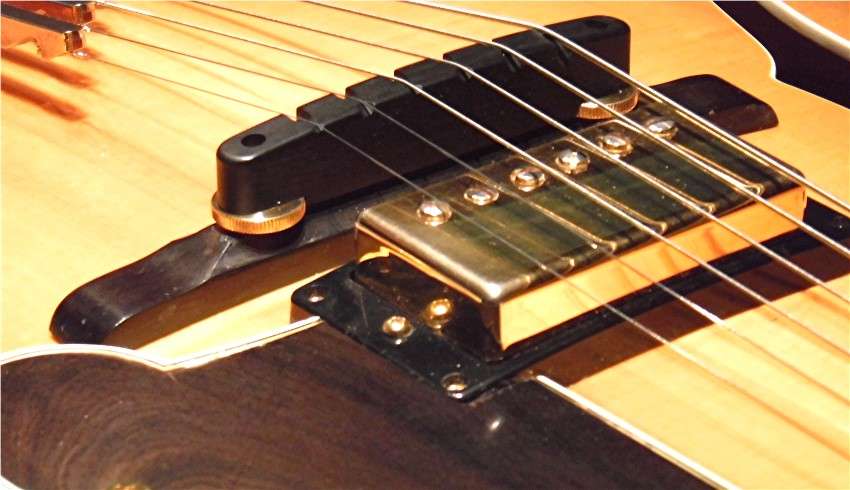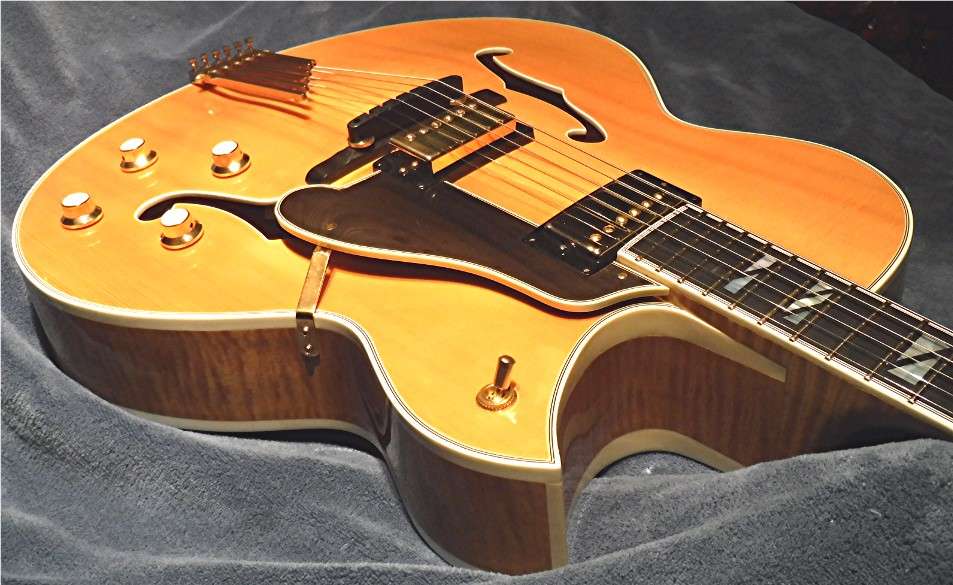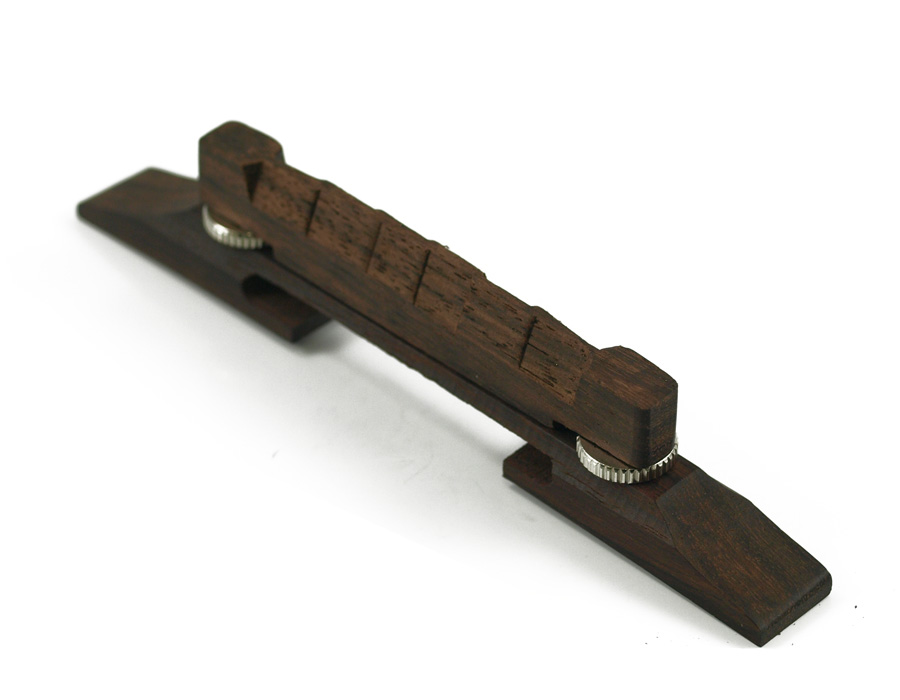-
Here is the bridge I am using on my latest builds. The base on these are narrow at 1/2" but for Joe's guitar I think a wider base may be best. Something close to what is on there now only thicker. A bridge with a smaller footprint might not cover any marks left by the old bridge. Some builders like the base very wide. I prefer a bridge with a more narrow two footed style base.
-
12-12-2017 02:56 PM
-
For sure, I've run into issues with the adjustment posts splaying wide enough to disallow thumb wheel adjustment so I just open the hole with a drill into more of an oval shape so the posts can move more freely.
 Originally Posted by icr
Originally Posted by icr
-
In that pic you can see the base had enough material removed to exagerate the mass left on the ends.
 Originally Posted by Max405
Originally Posted by Max405
My thinking is that this is not ideal, because those thick parts at the ends are not in the right place to help with strength OR transfer, and are just doing more than they need to as sound damper.
In other words, the extra mass at the ends is absorbing more vibration than a differently proportioned base would.
I've just started (slowly) to approach carving bases, and did find out that some mandolin builders have really covered bridge design theories well in forums, and they've done a lot of testing. I do understand construction is different between different instruments (esp. don't expect much violin family theory to apply) but it is good to see their approaches to similar issues. Below is the first Gabon Ebony base I made for my PM2, I think aesthetically and structurally, having greatest mass sections directly under the saddle studs is best, and listening tells me how it worked.
I think the bridge conforming to the top is a difficult problem for guitars, as you really need to fit it individually, not something that is easily sourced and "fits" right out of the box.
What I started to do now, to get the base to fit the top, is start with a piece of softwood to get the basic contour right off the guitar, then use that softwood as a pattern on my router table to intially cut the base bottom in the ebony stock. Much faster to rough out the shape this way and get really close before ever taking the ebony base to the guitar top. This "carved" base I made was almost all done with a router, instead of files/chisels. Straight from router table to finishing the work with sandpapers to blend edges and burnish to a sheen, and of course final fitting to the guitar top.
John
-
John,
1st off, thanks for giving this issue that much thought and consideration.
Your assessment makes a huge amount of sense to me.
I don’t know why Heritage built this bridge so insanely wide. Vinny said the same thing.
And the mass seems to be poorly located.
I think the new bridge is going to make this guitar perfect.
I appreciate your very logical opinion.
Thanks, Joe D
-
By the way, when I 1st received the guitar the edges of the bridge were elevated off the top.
If I played the guitar aggressively, I could hear a vibration under the base. I placed a piece of a light pick under the edges and the vibration went away.
Thats why I had my guy fit the bridge to the top properly.
I am getting the sense that such a wide bridge base was a poor design by Heritage. The width of the base extends about an inch beyond the braces. So, I don’t see why the base is so darn wide.
If I used heavier strings, this guitar would be incredibly loud. Volume is not really a problem. I want the guitar to sustain better and I want the notes to blossom. They seem to die before they blossom fully.
Perhaps the reason the guitar doesn’t sound similar to my Gibson Johnny Smith is because of the thickness of the top. And the width of the bridge deadens top vibration?
Mmmm..
-
It's a well documented fact here, even by Mr. P, that bridges were not the forte of Heritage guitars. That's one of the reasons Patrick had Gagnon built bridges on many of his Heritage guitars. You're better off starting fresh with a tailor made bridge JD.
-
Even MartyGrass would agree with that 2b.
-
Joe,
Why not have your guy take that base, that already fits the top, and shave off the excess on the ends?
He could trim the overall length + lower those lumps down to have it taper in a more conventional way.
I know the original concern was about the gap between saddle and base after the first adjustments removed 'meat' from both pieces, and trimming the base ends now won't change that either way. But I'd want to try making that base work -- it already fits the top now and trimming the ends might reveal if that (extra mass at ends) was a real factor. Ebony is really stiff, as are the steel studs. Having a little less base height and a little more stud length may not be completely bad, even if the gap looks bigger than expected.
If you had other saddle pieces to try on that base, it might be worth experimenting (Matt Cushman had suggested changing saddle earlier). I think that trimming the base ends is an almost can't lose option (if it works, you've salvaged the base that already fits), and then changing saddles might be easier than starting from scratch with a whole new bridge. Retaining that original base would mean any new saddles need the same stud spacing, so you'll need a measurement to select or spec a new part.
That Heritage JS is such a great guitar, I know in the end you will succeed in getting the most out of it.
John
-
Trouble with cutting off the ends is then you have ugly top gouges that now show and probably a good 2 shades lighter in color. Our man Matt will do Joe right with a whole new bridge assembly.
The best fret job I ever played was done by Matt Cushman. He also carves his tops like a true 1939 L5P. Not like how Gibson does it now. He carves his tops the way Johnny Smith demanded.
Note the cutaway carve on his Trophy model above. That is the right way.
-
Andy Griffith played a D18; now I’m really confused.
-
Good lord, it's easy enough. The base has now been properly fitted to the guitar. Leave it alone - it's fine.
All you need to do as add wood height to the top part of the bridge, so that there is far less exposed threaded rod. The posts are a standard width:
Door #1- you can buy that part,
Door #2 -have one made
Door #3 -simply glue a piece of ebony to the underside of the existing top part of the bridge and shape it to blend with the original. It's easy. I've done it many times and my experience has been that it significantly improves the sound of the guitar.
If you really want to hurt your brain, instead of adding depth to the top part of the bridge by gluing some ebony, use a piece of brass, or a laminate of ebony and brass.
While all this is happening, install a tune-o-matic top part (the holes should line up) so you can continue to use the guitar. Hey, you may like the sound with the tune-o-matic even better. Or not.Last edited by Hammertone; 12-13-2017 at 03:58 PM.
-
Hammer,
Thanks for offering your perspective.
I am afraid the problem is, I have other guitars. And when I play them, they make this guitar sound thin.
I will get this right. And the guitar will be the best guitar I've ever played. Which is saying a lot because I've played a few.
I've toyed with the idea of laminating strips of Stewmac ebony onto the base of the bridge and bridge top. But in the end, it is probably a less shoddy affair if I just have the bridge re-done the right way. This guitar deserves it.
Me, Heritage Guitars and anything having to do with bridges - as a trio - just don't get along.
Thanks, Joe D.
-
Sounds like Door#1 or Door#2 to me.
 Originally Posted by Max405
Originally Posted by Max405
-
Go with door #2
-
If you want a Jimmy D'AQ bridge like Vinnie 1K mentioned, you could try Roger Borys. He's right there in Hoboken, and works fast.
He made a new bridge for my Snakehead D'A that I'm very happy with.
Just don't use a metal bridge on an acoustic archtop!
-
jimmy D's wedge bridge..unique..all ebony...sleek profile..(art deco!)...monteleone was the guy who worked on 'em after jimmys passing

cheers
-
I've always envisioned my cuff catching the end of the wedge that's sticking out and snapping it off.

-
You are not off base, Cunamara. I have one of those bridges on an archtop and it is indeed a hazard for cuffs! I actually quite dislike the design. There is only one adjustment point, so you cannot independently control the height of the treble and bass ends, which I prefer to do. You are stuck with the slider's slope unless you want to break out the sand paper (which of course I did).
-
Another bridge that uses a more contained wedge system for adjustment is the Brekke bridge for mandolin. I think a guitar bridge of similar design might be fun to experiment with.
-
The Brekke design features the ability to tilt the bridge, raising the treble and bass ends independently. But as soon as you do this, the vertical contact surface is no longer along the full edges of the wedges. So the idea of broad wooden contact sort of falls apart once you tilt the bridge.
New Album Title suggestions:
Edges of the Wedges
Broad Wooden Contact
It does seem that, in practice, a wooden bridge and base on steel posts and wheels works quite well. And when it fails, the fix seems well within the range of a new saddle or base, or both.
I would be more concerned about a very shallow saddle, than a shallow base. But this stuff is easy to make, so easy enough to just go with new parts on both.
I looked into the earlier mentioned varieties of Ebony having some assumed (as best I can tell, it was assumed) effect on “tone” based on widely varied hardness or density. The varieties of Ebony any of us are likely to use are all very close in terms of hardness and density. Piece to piece variation will likely be as much as the variation in the average figures for one species to another.
I hope then OP lets us know what eventually happens with this. Surely Matt is the guy to go to for help on this. Looking forward to hearing how it all works out.
Chris
-
Hi Chris. Joe is going to send me his old bridge and with that I should be able to make a bridge that will fit his guitar without too much fitting needed to get it well seated. I will have to check with Joe to see what style he wants. I will take some pictures.
 Originally Posted by ptchristopher3
Originally Posted by ptchristopher3
I think the Brekke bridge is limited to height adjustment. You can't tilt the saddle without losing contact as you point out. That would limit adjustment to lowering or lifting by moving both sides together. When you tilt a saddle using the thumbscrews on a standard bridge the saddle can make uneven contact with the thumbwheels which seems to make very little difference in the tone so it may not be very important.
-
Hi Matt,
Yes, when considering that the wheel to post contact is along a very sloppy thread fit, a little tilt to the bridge seems unimportant. I notice that with modest tilts the wheels settle in flat against the bridge. So the tilt ends up affecting the sit of the wheel thread on the post thread.
Looking forward to seeing the bridge and Joe’s sonic result.
Chris
-
I have a Sadowsky True-Tone on my Super KB. I'm very happy with it-the intonation is very good for a non-adjustable:
True-Tone Bridge – Sadowsky Guitars


-
Matt,
i sent the bridge today. you should have it on Monday.
i am so looking forward to you working your Magic here.
The outpouring of ideas from our forum experts is priceless to me. Chris, Matt, SS, Vinny, Helios, Hammer sgcim And everyone else, thanks very much.
my ultimate plan is to gain thickness and sustain. Where less effort is required to make the notes blossom. I feel now that the notes are thin and the attack of the notes are off.
Thanks again gentlemen.
Joe D
-
I know it's an old thread,
 Originally Posted by Max405
Originally Posted by Max405
But what was the outcome Joe?
S




 Reply With Quote
Reply With Quote








Part 2 Secrets to McCoy Tyner using 4ths,...
Today, 07:31 PM in Improvisation